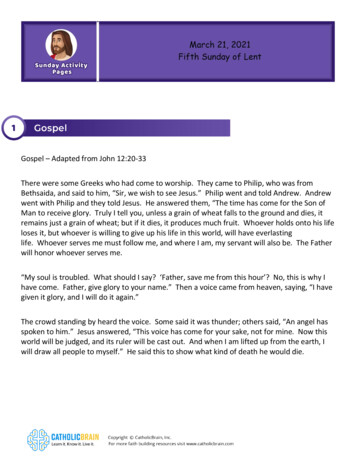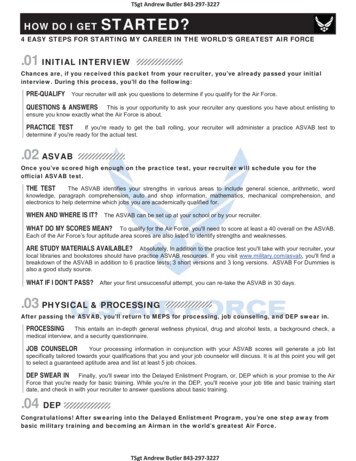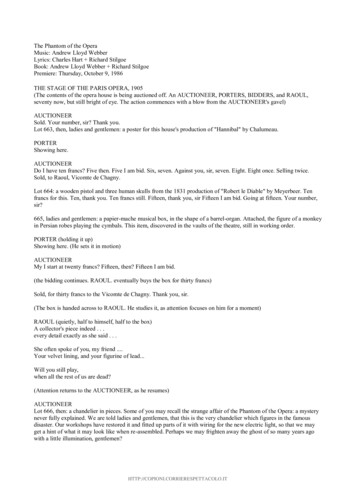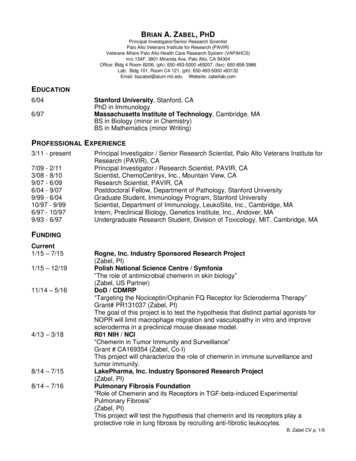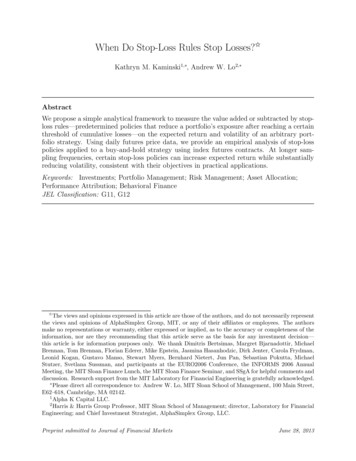
Transcription
When Do Stop-Loss Rules Stop Losses? Kathryn M. Kaminski1, , Andrew W. Lo2, AbstractWe propose a simple analytical framework to measure the value added or subtracted by stoploss rules—predetermined policies that reduce a portfolio’s exposure after reaching a certainthreshold of cumulative losses—on the expected return and volatility of an arbitrary portfolio strategy. Using daily futures price data, we provide an empirical analysis of stop-losspolicies applied to a buy-and-hold strategy using index futures contracts. At longer sampling frequencies, certain stop-loss policies can increase expected return while substantiallyreducing volatility, consistent with their objectives in practical applications.Keywords: Investments; Portfolio Management; Risk Management; Asset Allocation;Performance Attribution; Behavioral FinanceJEL Classification: G11, G12 The views and opinions expressed in this article are those of the authors, and do not necessarily representthe views and opinions of AlphaSimplex Group, MIT, or any of their affiliates or employees. The authorsmake no representations or warranty, either expressed or implied, as to the accuracy or completeness of theinformation, nor are they recommending that this article serve as the basis for any investment decision—this article is for information purposes only. We thank Dimitris Bertsimas, Margret Bjarnadottir, MichaelBrennan, Tom Brennan, Florian Ederer, Mike Epstein, Jasmina Hasanhodzic, Dirk Jenter, Carola Frydman,Leonid Kogan, Gustavo Manso, Stewart Myers, Bernhard Nietert, Jun Pan, Sebastian Pokutta, MichaelStutzer, Svetlana Sussman, and participants at the EURO2006 Conference, the INFORMS 2006 AnnualMeeting, the MIT Sloan Finance Lunch, the MIT Sloan Finance Seminar, and SSgA for helpful comments anddiscussion. Research support from the MIT Laboratory for Financial Engineering is gratefully acknowledged. Please direct all correspondence to: Andrew W. Lo, MIT Sloan School of Management, 100 Main Street,E62–618, Cambridge, MA 02142.1Alpha K Capital LLC.2Harris & Harris Group Professor, MIT Sloan School of Management; director, Laboratory for FinancialEngineering; and Chief Investment Strategist, AlphaSimplex Group, LLC.Preprint submitted to Journal of Financial MarketsJune 28, 2013
1. IntroductionThanks to the overwhelming dominance of the mean-variance portfolio optimizationframework pioneered by Markowitz (1952), Tobin (1958), Sharpe (1964), and Lintner (1965),much of the investments literature—both in academia and in industry—has focused on constructing well-diversified static portfolios using low-cost index funds. With little use foractive trading or frequent rebalancing, this passive perspective comes from the recognitionthat individual equity returns are difficult to forecast and trading is not costless. The questionable benefits of day-trading are unlikely to outweigh the very real costs of changingone’s portfolio weights. It is, therefore, no surprise that a “buy-and-hold” philosophy haspermeated the mutual-fund industry and the financial planning profession.3However, this passive approach to investing is often contradicted by human behavior,especially during periods of market turmoil.4 behavioral biases sometimes lead investorsastray, causing them to shift their portfolio weights in response to significant swings inmarket indexes, often “selling at the low” and “buying at the high.” On the other hand,some of the most seasoned investment professionals routinely make use of systematic rulesfor exiting and re-entering portfolio strategies based on cumulative losses, gains, and other“technical” indicators.In this paper, we investigate the efficacy of such behavior in the narrow context of stop3This philosophy has changed slightly with the recent innovation of a slowly varying asset allocation thatchanges according to one’s age (e.g., a “lifecycle” fund).4For example, psychologists and behavioral economists have documented the following systematic biasesin the human decisionmaking process: overconfidence (Fischoff and Slovic, 1980; Barber and Odean, 2001;Gervais and Odean, 2001), overreaction (DeBondt and Thaler, 1986), loss aversion (Kahneman and Tversky, 1979; Shefrin and Statman, 1985; Kahneman and Tversky, 1992; Odean, 1998), herding (Hubermanand Regev, 2001), psychological accounting (Kahneman and Tversky, 1981), miscalibration of probabilities(Lichtenstein, Fischoff, and Phillips, 1982), hyperbolic discounting (Laibson, 1997), and regret (Bell, 1982a,b;Clarke, Krase, and Statman, 1994).2
loss rules (i.e., rules for exiting an investment after some threshold of loss is reached andre-entered after some level of gains is achieved). We wish to identify the economic motivationfor stop-loss policies so as to distinguish between rational and behavioral explanations forthese rules. While certain market conditions may encourage irrational investor behavior(e.g., large rapid market declines) stop-loss policies are sufficiently ubiquitous that their usecannot always be irrational.This raises the question we seek to answer in this paper: When do stop-loss rules stoplosses? In particular, because a stop-loss rule can be viewed as an overlay strategy for aspecific portfolio, we can derive the impact of that rule on the return characteristics of theportfolio. The question of whether or not a stop-loss rule stops losses can then be answeredby comparing the expected return of the portfolio with and without the stop-loss rule. If theexpected return of the portfolio is higher with the stop-loss rule than without it, we concludethat the stop-loss rule does, indeed, stop losses.Using simple properties of conditional expectations, we are able to characterize themarginal impact of stop-loss rules on any given portfolio’s expected return, which we defineas the “stopping premium.” We show that the stopping premium is inextricably linked tothe stochastic process driving the underlying portfolio’s return. If the portfolio follows arandom walk (i.e., independently and identically distributed returns) the stopping premiumis always negative. This may explain why the academic and industry literature has lookedaskance at stop-loss policies to date. If returns are unforecastable, stop-loss rules simplyforce the portfolio out of higher-yielding assets on occasion, thereby lowering the overallexpected return without adding any benefits. In such cases, stop-loss rules never stop losses.3
However, for non-random-walk portfolios, we find that stop-loss rules can stop losses. Forexample, if portfolio returns are characterized by “momentum” or positive serial correlation,we show that the stopping premium can be positive and is directly proportional to themagnitude of return persistence. Not surprisingly, if conditioning on past cumulative returnschanges the conditional distribution of a portfolio’s return, it should be possible to find astop-loss policy that yields a positive stopping premium. We provide specific guidelines forfinding such policies under several return specifications: mean reversion, momentum, andMarkov regime-switching processes. In each case, we are able to derive explicit conditionsfor stop-loss rules to stop losses.Of course, focusing on expected returns does not account for risk in any way. It maybe the case that a stop-loss rule increases the expected return but also increases the riskof the underlying portfolio, yielding ambiguous implications for the risk-adjusted return ofa portfolio with a stop-loss rule. To address this issue, we compare the variance of theportfolio with and without the stop-loss rule and find that, in cases where the stop-loss ruleinvolves switching to a lower-volatility asset when the stop-loss threshold is reached, theunconditional variance of the portfolio return is reduced by the stop-loss rule. A decrease inthe variance coupled with the possibility of a positive stopping premium implies that, withinthe traditional mean-variance framework, stop-loss rules may play an important role undercertain market conditions.To illustrate the empirical relevance of our analysis, we apply a simple stop-loss rule toa standard asset-allocation problem of stocks versus bonds using daily futures data fromJanuary 1993 to November 2011. We find that stop-loss rules exhibit positive stopping4
premiums over longer sampling frequencies over larger range of threshold values. Thesepolicies also provide substantial reduction in volatility creating larger Sharpe ratios as aresult. This is a remarkable feat for a buy-high/sell-low strategy. For example in onecalibration, using stop loss over monthly intervals in daily data can increase the return by1.5% and decrease the volatility by 5% causing an increase in the Sharpe Ratio by as muchas 20%. These results suggest that stop-loss rules may exploit conditional momentum effectsfollowing periods of losses in equities. These results suggest that the random walk model is aparticularly poor approximation to U.S. stock returns and may improperly value the use ofnon-linear policies such as stop-loss rules. This is consistent with Lo and MacKinlay (1999)and others using various methods to examine limitations of the random walk.2. Literature ReviewBefore presenting our framework for examining the performance impact of stop-loss rules,we provide a brief review of the relevant portfolio-choice literature, and illustrate some of itslimitations to underscore the need for a different approach.The standard approach to portfolio choice is to solve an optimization problem in a multiperiod setting, for which the solution is contingent on two important assumptions: thechoice of objective function and the specification of the underlying stochastic process forasset returns. The problem was first posed by Samuelson (1969) in discrete time and Merton(1969) in continuous time, and solved in both cases by stochastic dynamic programming.As the asset-pricing literature has grown, this paradigm has been extended in a number ofimportant directions.55For a comprehensive summary of portfolio choice see Brandt (2004). Recent extensions include pre-5
However, in practice, household investment behavior seems to be at odds with financetheory. In particular, Ameriks and Zeldes (2004) observe that most observed variation in anindividuals portfolio is attributed to a small number of significant decisions they make asopposed to marginal adjustments over time. Moreover, other documented empirical characteristics of investor behavior include non-participation (Calvet, Campbell, and Sodini 2006);under-diversification (Calvet, Campbell, and Sodini 2006); limited monitoring frequency andtrading (Ameriks and Zeldes 2004); survival-based selling decisions or a “flight to safety”(Agnew 2003); an absence of hedging strategies (Massa and Simonov, 2004); and concentration in simple strategies through mutual-fund investments (Calvet, Campbell, and Sodini2006). Variations in investment policies due to characteristics such as age, wealth, andprofession have been examined as well.6In fact, in contrast to the over-trading phenomenon documented by Odean (1999) andBarber and Odean (2000), Agnew (2003) asserts that individual investors actually tradeinfrequently. By examining asset-class flows, she finds that investors often shift out ofequities after extremely negative asset returns into fixed-income products, and concludesthat in retirement accounts, investors are more prone to exhibit a “flight to safety” insteadof explicit return chasing. Given that one in three of the workers in the United Statesparticipate in 401(k) programs, it is clear that this flight to safety could have a significantdictability and autocorrelation in asset returns (Kim and Omberg, 1996; Liu, 1999; Campbell and Viceria,1999; Brennan and Xia, 2001; Xia, 2001; and Wachter, 2002), model uncertainty (Barberis, 2000), transaction costs (Balduzzi and Lynch, 1999), stochastic opportunity sets (Brennan, Schwartz, and Lagnado, 1997;Campbell, Chan, and Viceria, 2003; and Brandt, Goyal, Santa-Clara, and Stroud, 2005), and behavioralfinance (see the references in footnote 4).6For example, lack of age-dependence in allocation, lower wealth and lower education with greater nonparticipation and under-diversification, and greater sophistication in higher wealth investors have all beenconsidered (see Ameriks and Zeldes, 2004).6
impact on market prices as well as demand. Consistent with Agnew’s flight-to-safety inthe empirical application of stop-loss, we find momentum in long-term bonds as a result ofsustained periods of loss in equities. This suggests conditional relationships between stocksand bonds, an implication that is also confirmed by our empirical results.7Although stop-loss rules are widely used, the corresponding academic literature is ratherlimited. The market microstructure literature contains a number of studies about limitorders and optimal order selection algorithms (Easley and O’Hara, 1991; Biais, Hillion,and Spatt, 1995; Chakravarty and Holden, 1995; Handa and Schwartz, 1996; Harris andHasbrouck, 1996; Seppi, 1997; and Lo, MacKinlay, and Zhang, 2002). Carr and Jarrow(1990) investigate the properties of a particular trading strategy that employs stop-lossorders, and Shefrin and Statman (1985) and Tschoegl (1988) consider behavioral patternsthat may explain the popularity of stop-loss rules. However, to date, there has been nosystematic analysis of the impact of a stop-loss rule on an existing investment policy, anoversight that we remedy in this paper.3. A Framework for Analyzing Stop-Loss RulesIn this section, we outline a framework for measuring the impact of stop-loss policies oninvestment performance. In Section 3.1, we begin by specifying a simple stop-loss policyand deriving some basic statistics for its effect on an existing portfolio strategy. We describeseveral generalizations and qualifications of our framework in Section 3.2, and then applyour framework in Section 4 to various return-generating processes including the Random7Although excess performance in long-term bonds may seem puzzling, from a historical perspective, thederegulation of long-term government fixed-income products in the 1950s could provide motivation for theexistence of these effects.7
Walk Hypothesis, momentum and mean-reversion models, and regime-switching models.3.1. Assumptions and definitionsConsider any arbitrary portfolio strategy P with returns {rt } that satisfy the followingassumptions:(A1) The returns {rt } for the portfolio strategy P are stationary with finite mean µ andvariance σ 2 .(A2) The expected return µ of P is greater than the risk-free rate rf , and let π µ rfdenote the risk premium of P .Our use of the term “portfolio strategy” in Assumption (A1) is meant to underscore thepossibility that P is a complex dynamic investment policy, not necessarily a static basket ofsecurities. Assumption (A2) simply rules out perverse cases where stop-loss rules add valuebecause the “safe” asset has a higher expected return than the original strategy itself.Now suppose an investor seeks to impose a stop-loss policy on a portfolio strategy. Thistypically involves tracking the cumulative return Rt (J) of the portfolio over a window of Jperiods, where:8JXRt (J) rt j 1(1)j 1and when the cumulative return crosses some lower boundary, reducing the investment inP by switching into cash or some other safer asset. This heuristic approach motivates the8For simplicity, we ignore compounding effects and define cumulative returns by summing simple returns rtinstead of multiplying (1 rt ). For purposes of defining the trigger of our stop-loss policy, this approximationdoes not have significant impact. However, we do take compounding into account when simulating theinvestment returns of a portfolio with and without a stop-loss policy.8
following definition:Definition 1. A simple stop-loss policy S(γ, δ, J) for a portfolio strategy P with returns{rt } is a dynamic binary asset-allocation rule {st } between P and a risk-free asset F withreturn rf , where st is the proportion of assets allocated to P , and:st 0 1 1 0ififififRt 1 (J)rt 1Rt 1 (J)rt 1 γ and st 1 δ and st 1 γ and st 1 δ and st 1 1 0 1 0(exit)(re-enter)(stay in)(stay out)(2)for γ 0. Denote by rst the return of portfolio strategy S, which is the combinaton of portfoliostrategy P and the stop-loss policy S, hence:rst st rt (1 st )rf .(3)Definition 1 describes a 0/1 asset-allocation rule between P and the risk-free asset F , where100% of the assets are withdrawn from P and invested in F as soon as the J-period cumulative return Rt1 (J) reaches some loss threshold γ at t1 . The stop-loss rule stays in place untilsome future date t2 1 t1 when P realizes a return rt2 1 greater than δ, at which point100% of the assets are transferred from F back to P at date t2 . Therefore, the stop-loss policy S(γ, δ, J) is a function of three parameters: the loss threshold γ, the re-entry thresholdδ, and the cumulative-return window J. Of course, the performance of the stop-loss policyalso depends on the characteristics of F —lower risk-free rates imply a more significant dragon performance during periods when the stop-loss policy is in effect.Note that the specification of the loss and re-entry mechanisms are different; the exitdecision is a function of the cumulative return Rt 1 (J), whereas the re-entry decision involves9
only the one-period Return, rt 1 . This is intentional, and motivated by two behavioralbiases. The first is loss aversion and the disposition effect, in which an individual becomesless risk-averse when facing mounting losses. The second is the “snake-bite” effect, in whichan individual is more reluctant to re-enter a portfolio after experiencing losses from thatstrategy. The simple stop-loss policy in Definition 1 is meant to address both of thesebehavioral biases in a systematic fashion.To gauge the impact of the stop-loss policy S on performance, we define the followingmetric:Definition 2. The stopping premium µ (S) of a stop-loss policy S is the expected returndifference between the stop-loss policy S and the portfolio strategy P : µ E[rst ] E[rt ] po rf E[rt st 0] ,where po Prob(st 0)(4)(5)and the stopping ratio is the ratio of the stopping premium to the probability of stoppingout: µ rf E[rt st 0] .po(6)Note that the difference of the expected returns of rst and rt reduces to the product of theprobability of a stop-loss po and the conditional expectation of the difference between rf andrt , conditioned on being stopped out. The intuition for this expression is straightforward:the only times rst and rt differ are during periods when the stop-loss policy has been trig-10
gered. Therefore, the difference in expected return should be given by the difference in theconditional expectation of the portfolio with and without the stop-loss policy—conditionedon being stopped out—weighted by the probability of being stopped out.The stopping premium (4) measures the expected-return difference per unit time betweenthe stop-loss policy S and the portfolio strategy P , but this metric may yield misleadingcomparisons between two stop-loss policies that have very different parameter values. Forexample, for a given portfolio strategy P , suppose S1 has a stopping premium of 1% andS2 has a stopping premium of 2%; this suggests that S2 is superior to S1 . But suppose theparameters of S2 implies that S2 is active only 10% of the time (i.e., one month out of every10 on average), whereas the parameters of S1 implies that it is active 25% of the time. Ona total-return basis, S1 is superior, even though it yields a lower expected-return differenceper-unit-time. The stopping ratio µ /po given in (6) addresses this scale issue directly bydividing the stopping premium by the probability po . The reciprocal of po is the expectednumber of periods that st 0 or the expected duration of the stop-loss period. Multiplyingthe per-unit-time expected-return difference µ by this expected duration 1/po then yieldsthe total expected-return difference µ /po between rf and rt .The probability po of a stop-loss is of interest in its own right because more frequentstop-loss events imply more trading and, consequently, more transactions costs. Althoughwe have not incorporated transactions costs explicitly into our analysis, this can be doneeasily by imposing a return penalty in (3):rst st rt (1 st )rf κ st st 1 ,11(7)
where κ 0 is the one-way transactions cost of a stop-loss event. For expositional simplicity,we shall assume κ 0 for the remainder of this paper.Using the metrics proposed in Definition 2, we now have a simple way to answer thequestion posed in our title: stop-loss policies can be said to stop losses when the corresponding stopping premium is positive. In other words, a stop-loss policy adds value if and onlyif its implementation leads to an improvement in the overall expected return of a portfoliostrategy.Of course, this simple interpretation of a stop-loss policy’s efficacy is based purely onexpected return, and ignores risk. Risk matters because it is conceivable that a stop-losspolicy with a positive stopping premium generates so much additional risk that the riskadjusted expected return is less attractive with the policy in place than without it. Thismay seem unlikely because by construction, a stop-loss policy involves switching out ofP into a risk-free asset, implying that P spends more time in higher-risk assets than thecombination of P and S. However, it is important to acknowledge that P and S are dynamicstrategies and static measures of risk such as standard deviation are not sufficient statisticsfor the intertemporal risk/reward trade-offs that characterize a dynamic rational expectationsequilibrium (e.g., Merton, 1973; Lucas, 1978). Nevertheless, it is still useful to gauge theimpact of a stop-loss policy on volatility of a portfolio strategy P , as only one of possiblymany risk characteristics of the combined strategy. To that end, we have:12
Definition 3. Let the variance difference σ2 of a stopping strategy be given by: σ2 Var[rst ] Var[rt ](8) E Var[rst st ] Var E[rst st ] E Var[rt st ] Var E[rt st ] po Var[rt st 0] 2 2µ E[rt st 0]po (1 po ) rf E[rt st 0] 1 po(9)(10)From an empirical perspective, standard deviations are often easier to interpret, hence wealso define the quantity σ pVar[rst ] σ.Given that a stop-loss policy can affect both the mean and standard deviation of theportfolio strategy P , we can also define the difference between the Sharpe ratios of P withand without S: SR E[rst ] rfµ rf .σsσ(11)However, given the potentially misleading interpretations of the Sharpe ratio for dynamicstrategies such as P and S, we refrain from using this metric for evaluating the efficacy ofstop-loss policies.93.2. Generalizations and QualificationsThe basic framework outlined in Section 3.1 can be generalized in many ways. Forexample, instead of switching out of P and into a completely risk-free asset, we can allowF to be a lower-risk asset but with some non-negligible volatility. More generally, instead9See Sharpe (1994), Spurgin (2001), and Lo (2002) for details.13
of focusing on binary asset-allocation policies, we can consider a continuous function ω(·) [0, 1] of cumulative returns that declines with losses and rises with gains. Also, instead of asingle “safe” asset, we might consider switching into multiple assets when losses are realized,or incorporate the stop-loss policy directly into the portfolio strategy P itself so that theoriginal strategy is affected in some systematic way by cumulative losses and gains. Finally,there is nothing to suggest that stop-loss policies must be applied at the portfolio level—suchrules can be implemented security-by-security or asset-class by asset-class.Of course, with each generalization, the gains in flexibility must be traded off againstthe corresponding costs of complexity and analytic intractability. These trade-offs can onlybe decided on a case-by-case basis, and we leave it to the reader to make such trade-offsindividually. Our more modest objective in this paper is to provide a complete solution forthe leading case of the simple stop-loss policy in Definition (1). From our analysis of thissimple case, a number of generalizations should follow naturally, some of which are exploredin Kaminski (2006).However, an important qualification regarding our approach is the fact that we do notderive the simple stop-loss policy from any optimization problem—it is only a heuristic,albeit a fairly popular one among many institutional and retail investors. This is a distinctdeparture from much of the asset-pricing literature in which investment behavior is modelledas the outcome of an optimizing individual seeking to maximize his expected lifetime utilityby investing in a finite set of securities subject to a budget constraint (e.g., Merton, 1971).While such a formal approach is certainly preferable if the consumption/investment problemis well posed. For example, if preferences are given and the investment opportunity set is14
completely specified, the simple stop-loss policy can still be studied in the absence of suchstructure.Moreover, from a purely behavioral perspective, it is useful to consider the impact of astop-loss heuristic even if it is not derived from optimizing behavior, precisely because weseek to understand the basis of such behavior. Of course, we can ask the more challengingquestion of whether the stop-loss heuristic can be derived as the optimal portfolio rule fora specific set of preferences, but such inverse-optimal problems become intractable veryquickly (e.g., Chang, 1988). Instead, we have a narrower set of objectives in this paper:to investigate the basic properties of simple stop-loss heuristics without reference to anyoptimization problem, and with as few restrictions as possible on the portfolio strategy Pto which the stop-loss policy is applied. The benefits of our narrower focus are the explicitanalytical results described in Section 4, and the intuition that they provide for how stop-lossmechanisms add or subtract value from an existing portfolio strategy.Although this approach may be more limited in the insights it can provide to the investment process, the siren call of stop-loss rules seems so universal that we hope to derive someuseful implications for optimal consumption and portfolio rules from our analysis. Moreover,the idea of overlaying one set of heuristics on top of an existing portfolio strategy has a certain operational appeal that many institutional investors have found so compelling recently(e.g., so-called “portable alpha” strategies). Overlay products can be considered a generalclass of “superposition strategies,” which is explored in more detail in Kaminski (2006).15
4. Analytical ResultsHaving defined the basic framework in Section 3 for evaluating the performance of simplestop-loss rules, we now apply them to several specific return-generating processes for {rt },including the Random Walk Hypothesis in Section 4.1, mean-reversion and momentum processes in Section 4.2, and a statistical regime-switching model in Section 4.3. The simplicityof our stop-loss heuristic will allow us to derive explicit conditions under which stop-losspolicies can stop losses in each of these cases.4.1. The Random Walk HypothesisSince the Random Walk Hypothesis is one of the most widely used return-generatingprocesses in the finance literature, any analysis of stop-loss policies must consider this leadingcase first. Given the framework proposed in Section 3, we are able to derive a surprisinglystrong conclusion about the efficacy of stop-loss rules:Proposition 1. If {rt } satisfies the Random Walk Hypothesis so that:rtIID µ t , t White Noise(0, σ 2 ),(12)then the stop-loss policy has the following properties: µ po (rf µ) po π.(13a) µ π.po(13b) σ2 po σ 2 po (1 po )π 2 .(13c) SR µ ππ. σ σ2 σ 216(13d)
Proof: See Appendix A.1.Proposition 1 shows that, for any portfolio strategy with an expected return greaterthan the risk-free rate rf , the Random Walk Hypothesis implies that the stop-loss policywill always reduce the portfolio’s expected return since µ 0. In the absence of anypredictability in {rt }, whether or not the stop-loss is activated has no informational contentfor the portfolio’s returns; hence, the only effect of a stop-loss policy is to replace the portfoliostrategy P with the risk-free asset when the strategy is stopped out, thereby reducing theexpected return by the risk premium of the original portfolio strategy P . If the stop-lossprobability po is large enough and the risk premium is small enough, (13) shows that thestop-loss policy can also reduce the volatility of the portfolio.The fact that there are no conditions under which the simple stop-loss policy can addvalue to a portfolio with IID returns may explain why stop-loss rules have been given so littleattention in the academic finance literature. The fact that the Random Walk Hypothesiswas widely accepted in the 1960s and 1970s, and considered to be synonymous with marketefficiency and rationality, eliminated the motivation for stop-loss rules altogether. In fact, oursimple stop-loss policy may be viewed as a more sophisticated version of the “filter rule” thatwas tested extensively by Alexander (1961) and Fama and Blume (1966). Their conclusionthat such strategies did not produce any excess profits was typical of the outcomes of manysimilar studies during this period.However, despite the lack of interest in stop-loss rules in academic studies, investmentprofessionals have been using such rules for many years, and part of the reason for this dichotomy may be the fact that the theoretical motivation for the Random Walk Hypothes
tration in simple strategies through mutual-fund investments (Calvet, Campbell, and Sodini 2006). Variations in investment policies due to characteristics such as age, wealth, and profession have been examined as well.6 In fact, in contrast to the over-trading phenomenon documented by Odean (1999) and

